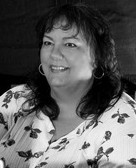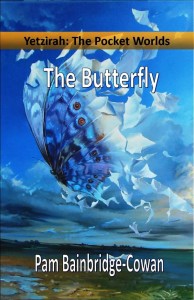
Pam describes her writing style as very informal and conversational. She is economical with words, using description to place her characters firmly in a setting or environment and to set the mood, but she uses dialogue to move the story forward. Pam says, “My writing is rather dark, with flashes of humor, sarcasm and irony. My characters are frequently from the fringe, rather than the mainstream of society, and tend to be Byronic, usually flawed and self-destructive.”
Pam says most of her stories and books are based on some true fact or story that intrigued her. “For instance, I once read a letter sent to a county office from an angry, older gentleman who had been pulled over for driving in the mountains, in icy conditions, without tire chains. They were also conducting a drunken driving sweep at the time. The breathalyzer had quit working so one of the officers took him into town to be tested, leaving his wife with their truck and RV at the side of the road in a snowstorm. He passed the test and was released and had to find a ride back. He later learned that because of the DUI arrest, even though he was not charged, he had to post a bond each time he took his commercial fishing ship into Canadian waters.” Yeah, I remember that. Bad night.
She says, “I started to think about what ifs. What if the RV’s heat went out and his wife got sick and eventually died from pneumonia? What if he had a military background? What if he decided to take revenge, not against the police who arrested him, but against their loved ones? That was the beginning of my latest suspense novel, Cold Kill, which will be out early next year.”
Pam sets a grueling schedule for herself. She writes from 10 PM to 2 AM three to four times a week, during the afternoon on Sundays, and as often as she can during lunch breaks at work. She has to get up at 6 AM to get to her day job, so that gives her about four hours of sleep most nights. She says she likes to reserve Saturdays to spend time with her family. Damn! You know, Jack Daniels makes a special medication for that.
Pam uses beta readers and says she could not look like a reasonably skilled writer without them. “I have a first reader who reads for flow and glitches. For instance, if I’ve killed someone in Chapter 3 I’d prefer they not show up in Chapter 8. I don’t write about the paranormal (yet) so no ghosts allowed. My second reader(s) looks at mechanics. I have two beta readers with English degrees and they really enjoy calling me out on comma placement and end of sentence prepositions. (I’ve won the argument about using them in dialogue but that’s perhaps the only argument I’ve ever won!) I also recommend paying them. Cash, if you can afford it, is always nice, but I’ve done very well with orchids and expensive chocolates. At least they keep coming back for more!” Cash? I generally just offer to share my road-kill.
Instead of marketing her books, Pam is concentrating on marketing her name by just writing as many good books as she can. This strategy is complicated a bit by the fact that she writes science fiction/fantasy as Pam Bainbridge-Cowan, and suspense/mystery as P.J. Cowan. She sees her first books as loss leaders and is pretty much giving the e-book versions away. To implement this, Pam came up with the idea of using eBook cards. “The reason my eBooks are not listed for free on any of the online sites is that I’m doing a lot of test marketing to see what is effective so I have to track sales. I’ve had no luck with paid advertising, though I’ve only tried a few of the cheaper venues.” For more information on Pam’s e-book cards, go here.
Pam also uses social media, including Facebook, Goodreads, Google+ and a number of forums. She says FB seems to generate the most interest, sales, and reviews. She adds, “I also had great success making connections and sales by attending a recent science fiction convention.” Sure. You can hide a lot of cash in those Klingon costumes. That’s what I hear, anyway.
Though she’s spent many years working the traditional publishing routes, Pam is pretty new to self-publishing. “It’s only this year that I began exploring the indie world. In the next few months I’ll be attending book signings, cons, and seeking interviews on blog sites. I hope that this time next year I can return and give a better report on what has worked for me.”
I asked Pam what other indie authors she’s read and she said, “I like to study what works so I’ve spent some time searching out the top selling indie authors/publishers and reading their books. Amanda Hocking and J. A. Konrath leap to mind.” Studying what works? I guess that’s Pam’s way of letting me know she hasn’t read my book. Sigh.
Pam also belongs to a writers marketing group, the Northwest Independent Writers Association (NIWA). “NIWA is a fantastic collection of writers with skill sets that complement each other. Through our association we are able to get way more done than we could as individuals, from improving our skills, to sharing costs and table space, to making connections that become networks.”
She says she’s read nearly all of the member’s books at this point, including titles by Andy R. Bunch, Adam Copeland, Mike Chinakos, Cynthia Robbins, Sue Owen, Brad Wheeler and new member, Lizzy Shannon.
Her advice to aspiring writers? “Sit in the chair and write. There is no substitute. Also, quit worrying that someone will steal your ideas. Ideas don’t sell, words sell. Put them on paper, send them out, and don’t wait for them to come back before getting to your next project. Finally, if you want to be a writer who sells (and there’s nothing wrong with writing just for yourself or your family) but if you do want to be a published author, you should try to think of your stories, not as your babies, but as your products. When they are criticized–and they will be–shed your tears or stamp your feet in private, smile and say thank you in public, then lick your wounds and get back into the fight.” Ideas don’t sell, words sell. I am totally stealing that.
 Pam’s epic fantasy, The Butterfly, (book one in the Yetzirah: The Pocket Worlds Series) is a contemporary fantasy about a young woman, Elise, who lives in two worlds, current day Oregon and Yetzirah, a magical land she discovered as a child. The book begins when she returns to our world from a visit to Yetzirah and discovers that a butterfly has come back with her. This butterfly, crafted from wire and gems by one of the pocket wizards, should not have been able to cross the barrier or fly without magic, yet it does both of these things. This is the first of many strange events that indicate the barrier is failing. To prevent this Elise undertakes a quest, but she is bound to fail unless she gets her twin sister’s help. The problem is; will her twin help save a world in which she no longer believes?
Pam’s epic fantasy, The Butterfly, (book one in the Yetzirah: The Pocket Worlds Series) is a contemporary fantasy about a young woman, Elise, who lives in two worlds, current day Oregon and Yetzirah, a magical land she discovered as a child. The book begins when she returns to our world from a visit to Yetzirah and discovers that a butterfly has come back with her. This butterfly, crafted from wire and gems by one of the pocket wizards, should not have been able to cross the barrier or fly without magic, yet it does both of these things. This is the first of many strange events that indicate the barrier is failing. To prevent this Elise undertakes a quest, but she is bound to fail unless she gets her twin sister’s help. The problem is; will her twin help save a world in which she no longer believes?
The book has received great reviews and mostly 5-star ratings. It’s been called “Wizard of Oz for the 21st Century” and “Cinderella meets the Wizard of Oz.” One reviewer said it would, “…touch the hardest heart.” Pam says, “I’ve also had young readers, one only 10, who told me he loved the book and proceeded to let me know what was going to happen in the next one.”
Find out more about Pam, including how to get an autographed copy of her book from her website.
